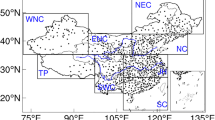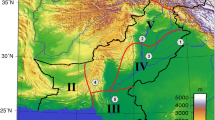Abstract
The urban heat environment in Nanjing metropolitan region is significantly affected by human activities. The days of high temperature and heat waves became increasingly obvious. Therefore, this paper aimed to reveal the temporal changes in high temperature and heat waves and analyze the relevant disasters. The results showed that the duration and average high temperature were both increasing during 1951–2013. Days of heat waves were mainly concentrated in August. The longest duration of extreme heat was in 2013 lasting 9 days. The major issues caused by high temperature and heat waves were energy consumption, power shortage, human health and human habitat deterioration. Land use change driven by human activities altered the underlying surface and accelerated urban heat island effect. These views provide scientific evidence for assisting urban planning and industrial restructuring in the future.






Similar content being viewed by others
References
Anderson GB, Bell ML (2011) Heat waves in the United States: mortality risk during heat waves and effect modification by heat wave characteristics in 43 US communities. Environ Health Perspect 119:210–218
Arnfield AJ (2003) Two decades of urban climate research: a review of turbulence, exchanges of energy and water, and the urban heat island. Int J Climatol 23:1–26
Artis DA, Carnahan WH (1982) Survey of emissivity variability in thermography of urban areas. Remote Sens Environ 12:313–329
Chen X (2013) Nanjing Children’s Hospital overcrowding caused by high temperature. http://www.weather.com.cn/news/2013/07/1918266.shtml
Chen XL, Zhao HM, Li PX, Yin ZY (2006) Remote sensing image-based analysis of the relationship between urban heat island and land use/cover changes. Remote Sens Environ 104:133–146
China Central Television (CCTV) (2013) The electricity survey in summer: electricity rose three percent in summer for citizens in Nanjing. http://tv.cntv.cn/video/C10330/7200e655ea7a4b79ba873bf7829bea1f?ptag=vsogou
Dessai S (2002) Heat stress and mortality in Lisbon part I. Model construction and validation. Int J Biometeorol 47:6–12
Fouillet A, Rey G, Jougla E, Frayssinet P, Bessemoulin P, Hémon D (2007) A predictive model relating daily fluctuations in summer temperatures and mortality rates. BMC Public Health 13:114
Gong P, Liang S, Carlton EJ, Jiang Q, Wu J, Wang L (2012) Urbanization and health in China. Lancet 379:843–852
Grimm NB, Faeth SH, Golubiewski NE, Redman CL, Wu J, Bai X (2008) Global change and the ecology of cities. Science 319:756–760
Gulyás Á, Matzarakis A (2007) Selected examples of bioclimatic analysis applying the physiologically equivalent temperature in Hungary. Acta Climatol Chorol 40:37–46
Höppe P (1999) The physiological equivalent temperature—a universal index for the bio-meteorological assessment of the thermal environment. Int J Biometeorol 43:71–75
Huang Y (2013) The first dead patient caused by high temperature in Nanjing. http://news.longhoo.net/nj/njxw/content/2013-07/30/content_10804282.htm
IPCC (2007) Climate change 2007: the physical science basis. Summary for policymakers. Cambridge University Press, Cambridge
Jiang Y (2003) Analysis of residents’ summer load characteristics in Nanjing. Relay 31:24–26 (in Chinese)
Kenney WL, Hodgson JL (1987) Heat tolerance, thermoregulation and aging. Sports Med 4:446–456
Kovats RS, Hajat S (2008) Heat stress and public health: a critical review. Annu Rev Public Health 29:41–55
Li YH, Chen XD, Lin P (2005) The impact of high temperature on population death in a district of Nanjing. J Environ Health 22:6–8
Liu L, Zhang YZ (2011) Urban heat island analysis using the Landsat TM data and Aster data: a case study in Hong Kong. Remote Sens 3:1535–1552
Liu JY, Liu ML, Tian HQ, Zhuang DF, Zhang ZX, Zhang W, Tang XM, Deng XZ (2005) Spatial and temporal patterns of China’s cropland during 1990–2000: an analysis based on Landsat TM data. Remote Sens Environ 98:442–456
Liu GL, Zhang LC, Zhang Q, Musyimi Z (2014) The response of grain production to changes in quantity and quality of cropland in Yangtze River Delta, China. J Sci Food Agric. doi:10.1002/jsfa.6745
Lv NF (2013) Sustained high temperatures resulted in aquatic plants soaring in Nanjing. http://www.njdaily.cn/2013/0801/529975.shtml
Markham BL, Barker JL (1985) Spectral characteristics of the LANDSAT Thematic Mapper sensors. Int J Remote Sens 6:697–716
Markham BL, Barker JL (1987) Radiometric properties of U.S. processed Landsat MSS data. Remote Sens Environ 22:39–71
Mazon J, Pino D, Barriendos M (2014) Rapid and sudden advection of warm and dry air in the Mediterranean Basin. Nat Hazards Earth Syst Sci 14:235–246
Moran MS, Jackson RD, Slater PN, Teilet PM (1992) Evaluation of simplified procedures for retrieval of land surface reflectance factors from satellite sensor output. Remote Sens Environ 4:169–184
Ouyang XJ, Lou Q, Gu LB (2012) Cardiovascular disease risk factors are highly prevalent in the office-working population of Nanjing in China. Int J Cardiol 155:212–216
Paerl PW, Huisman J (2008) Blooms like it hot. Science 320:57–58
Pengelly L, Campbell M, Chad F, Fu C, Gingrich S, Macfarlane R (2007) Anatomy of heat waves and mortality in Toronto: lessons for public health protection. Can J Public Health 98:364–368
Price JC (1987) Special issue on radiometric calibration of satellite data. Remote Sens Environ 22:1–158
Rey G, Jougla E, Fouillet A, Pavillon G, Bessemoulin P, Frayssinet P, Clavel J, Hemon D (2007) The impact of major heat waves on all-cause and cause-specific mortality in France from 1971 to 2003. Int Arch Occup Environ Health 80:615–626
Rinner C, Hussain M (2011) Toronto’s urban heat island—exploring the relationship between land use and surface temperature. Remote Sens 3:1251–1265
Robine JM, Cheung SLK, Roy SL, Van Oyen H, Griffiths C, Michel JP, Herrmann FR (2007) Death toll exceeded 70,000 in Europe during the summer of 2003. CR Biol 331:171–178
Rocklöv J, Ebi K, Forsberg B (2011) Mortality related to temperature and persistent extreme temperatures: a study of cause-specific and age-stratified mortality. Occup Environ Med 68:531–536
Shi B, Tang CS, Gao L, Liu C, Wang BJ (2012) Observation and analysis of the urban heat island effect on soil in Nanjing, China. Environ Earth Sci 67:215–229
Smoyer-Tomic KE, Kuhn R, Hudson A (2003) Heat wave hazards: an overview of heat wave impacts in Canada. Nat Hazards 28:463–485
Snyder WC, Wan Z, Zhang Y (1998) Classification based emissivity for land surface temperature measurement from space. Int J Remote Sens 19:2753–2774
Solheim AL, Austnes K, Eriksen TE, Seifert I, Holen S (2010) Climate change impacts on water quality and biodiversity: background report for EEA European Environment State and Outlook Report 2010 ETC Water Technical Report 1/2010. Czech Republic, Prague
United Union (2014) Human cause of global warming is near certainty. UN Daily News. http://www.un.org/apps/news/archive.asp
Voogt JA, Oke TR (2003) Thermal remote sensing of urban climates. Remote Sens Environ 86:370–384
Wang Y (2013) The situations of various hospitals under high temperature in Nanjing. http://www.chinanews.com/df/2013/08-06/5128962.shtml
Webb BW, Clack PD, Walling DE (2003) Water-air temperature relationships in a Devon river system and the role of flow. Hydrol Process 17:3069–3084
Weng QH, Lu DS, Schubring J (2004) Estimation of land surface temperature–vegetation abundance relationship for urban heat island studies. Remote Sens Environ 89:467–483
Whitehead PG, Wilby RL, Battarbee RW, Kernan M, Wade AJ (2009) A review of the potential impacts of climate change on surface water quality. Hydrol Sci J 54:101–123
Whitman S, Good G, Donoghue ER, Benbow N, Shou W, Mou S (1997) Mortality in Chicago attributed to the July 1995 heat wave. Am J Public Health 87:1515–1518
Wu F, Jing YS, Li XY, Zhou L, Chen XD (2013) Effect of heat wave on the death-toll of cardiovascular in Nanjing. J Environ Hyg 3:288–292 (in Chinese)
Xu TT, Yang Y (2013) Increase in patients with dermatitis due to high temperature. http://epaper.yzwb.net/html_t/2013-08/09/content_93698.htm?div=-1
Xu C, Liu MS, Yang XJ, Sheng S, Zhang MJ, Huang Z (2010) Detecting the spatial differentiation in settlement change rates during rapid urbanization in the Nanjing metropolitan region, China. Environ Monit Assess 171:457–470
Xu XZ, Zheng YF, Yin JF, Wu RJ (2011) Characteristics of high temperature and heat wave in Nanjing City and their impacts on human health. Chin J Ecol 30:2815–2820 (in Chinese)
Yang SG (2013) A hospital peak caused by high temperature. http://news.xinhuanet.com/politics/2013-08/22/c_117044265.htm
Yi Y, Dai D, Zhang NX, Zhou HQ, Yang HY, Yao RF (2013) A total of 6 people died caused by high-temperature in Nanjing. http://www.china.com.cn/zhuanti2005/txt/2003-07/31/content_5376491.htm
Yu F (2013) Sustained high temperatures caused the decline in water quality in Xuanwu Lake, Nanjing. http://js.people.com.cn/html/2013/10/23/263446.html
Yun Y (2013a) Jiangsu “high roast” weather pause and nearly 400 thousand ha crops affected by drought. http://www.js.chinanews.com/news/2013/0819/65226.html
Yun Y (2013b) Nanjing Bureau of Parks irrigated withered trees fight a drought caused by high temperature. http://www.js.chinanews.com/news/2013/0813/65097.html
Zhang ZY, Lu B (2013) Hundred people were suffering heat stroke caused by high temperature. http://njcb.jschina.com.cn/mp3/html/2012-07/29/content_608277.htm
Zhang SY, Zhang DK, Xu XD, Liao YM, Shen SQ, Yin DP (2005) Study on the mechanism and forecasting method of high temperature disaster in summer in the large cities of the Yangtze River Basin. J Nanjing Inst Meteorol 28:840–846 (in Chinese)
Zhang K, Wang R, Shen C, Da L (2010) Temporal and spatial characteristics of the urban heat island during rapid urbanization in Shanghai, China. Environ Monit Assess 169:101–112
Zhang N, Zhu LF, Zhu Y (2011) Urban heat island and boundary layer structures under hot weather synoptic conditions: a case study of Suzhou City, China. Adv Atmos Sci 28:855–865
Zhou F (2013) High temperature caused in deterioration of water quality of some rivers in Nanjing. http://www.jstv.com/df/nanjing/ms/201308/t20130814_1762380.shtml
Zhou LH, Wu WQ, Ge LD (2013) Citizens were suffering continued high temperature. http://news.eastday.com/m/20100804/u1a5371669.html
Zhou DC, Zhao SQ, Liu SG, Zhang LX, Zhu C (2014) Surface urban heat island in China’s 32 major cities: spatial pattern and drivers. Remote Sens Environ 152:51–61
Acknowledgments
This study was supported by the Public Projects of State Oceanic Administration (201005009-13), National Natural Science Foundation of China (No. 41130750), Knowledge Innovation Program of the Chinese Academy of Sciences (KZZD-EW-10-04) and Program 135 from Nanjing Institute of Geography and Limnology, Chinese Academy of Sciences (NIGLAS2012135006). The authors are also grateful to two anonymous reviewers.
Author information
Authors and Affiliations
Corresponding author
Rights and permissions
About this article
Cite this article
Liu, G., Zhang, L., He, B. et al. Temporal changes in extreme high temperature, heat waves and relevant disasters in Nanjing metropolitan region, China. Nat Hazards 76, 1415–1430 (2015). https://doi.org/10.1007/s11069-014-1556-y
Received:
Accepted:
Published:
Issue Date:
DOI: https://doi.org/10.1007/s11069-014-1556-y




